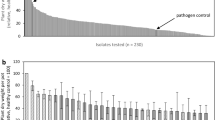Abstract
The effectiveness of twoStreptomyces spp. strains to controlpathogenic fungi was studied in stored maizegrain. The treatments included seeddisinfection and inoculation withStreptomyces spp. strains previously isolatedfrom maize rhizosphere. Actinomycete inoculumconsisted of filtered suspension and totalsuspension of fermentor-producedStreptomyces spp. strains biomass. Treatmentswith Streptomyces spp. strains aloneeffectively suppressed the development ofAspergillus spp., Curvularia lunata, andDrechslera maydis and significantly(p < 0,05) reduced the incidence ofFusarium subglutinans and Cephalosporiumacremonium. Among the inoculation treatments,nondisinfested seed inoculated with filteredsuspension was the only treatment that did notsuppress the development of Penicilliumspp. Maize seed inoculation with totalsuspension of strains was the most effectivetreatment to control the incidence of seedpathogenic fungi. The development of theDiplodia maydis was only suppressed by thecombination of seed disinfection andinoculation with total suspension of strains.Although, the strain DAUFPE 11470 showed thegreatest effectiveness for controlling thefungi pathogenic to seed, root and shootdevelopment was reduced by treatment with thisstrain.The results indicate thatStreptomyces spp. strains reduce the incidenceof seed pathogenic fungi and have potential asa biological control agent. However, an efficient methodof seed treatment with the biological controlagent must be developed before it can become anagricultural practice.
Similar content being viewed by others
References
Adams, P.D. and J.W. Kopler, 1996. Seed-borne bacterial endophytes in different cotton cultivars. Phytopatology 86: S97 (abstr.).
Bacon, C.W. and D.M. Hinton, 1996. Symptomless endophytic colonization of maize by Fusarium moniliforme. Can. J. Bot. 74: 1195–1202.
Bacon, C.W., I.E. Yates, D.M. Hinton and F. Meredith, 2001. Biological control of Fusarium moniliforme in maize. Environ. Health Perspect. 109: 325–332.
Blakeman, J.P., A.E. Brown and P.C. Mercer, 1992. Biological control of plant diseases – present and future trends. Pesq. Agropec. Bras. 27: 151–164.
Gesheva, V. and R. Gesheva, 2000. Physiological and antagonistic potential of actinomycetes from loquat rhizosphere. Microb. Res. 155(2): 133–135.
Gesheva, V., 2002. Rhizosphere microflora of some citrus as a source of antagonistic actiomycetes. Europ. J. Soil Biology 38(1): 85–88.
Gomes, R.C., L.T. Semêdo, R.M. Soares, C.S. Alviano, L.F. Linhares and R.R. Coelho, 2000. Chitinolytic activity of actinomycetes from a cerrado soil and their potential in biocontrol. Letters Appl. Microbiol 30(2): 146–150.
Harman, G.E., 1992. Development and benefits of rhizosphere competent fungi for biological control of plant pathogens. J. Plant Nutr. 15: 835–843.
Headrick, J.M. and J.K. Pataky, 1989. Resistance to kernel infection by Fusarium moniliforme in inbred lines of sweet corn and the effect of infection on emergence. Plant Dis. 73: 887–892.
Hebbar, P.K., D. Atkinson, W. Tucker and P.J. Dart, 1992. Supresssion of Fusarium moniliforme by maize root-associated Pseudomonas cepacia. Soil Biol. Biochem. 24: 1009–1022.
Hoenish, R.W. and R.M. Davis, 1994. Relationship between kernel pericarp thickness and susceptibility to Fusarium ear rot in filed corn. Plant Dis. 78: 517–519.
Huddleston, A.S., N. Cresswell, M.C. Neves, J.E. Beringer, S. Baumberg, D.I. Thomas and E.M. Wellington, 1997. Molecular detection of streptomycin-producing streptomycetes in Brasilian soils. Appl. Environ. Microbiol. 63(4): 1288–1297.
Kawamura, T., K. Tago, T. Beppeu and C. Arima, 1976. Taxonomy of the producing strain and study conditions for production of the antibiotic. J. Antibiot. 29: 242–247.
Kim, B.S., S.S. Moon and B.K. Hwang, 2000. Structure elucidation and fungal activity of an anthracycline antibiotic, daunomycin, isolated from Actinomadura roseola. J. Agr. Food Chem. 48(5): 1875–1881.
Lamanceau, P. and C. Alabouvette, 1991. Biological control of Fusarium diseases by fluorescent Pseudomonas and non-pathogenic Fusarium. Crop Prot. 10: 279–286.
Lange, L., J. Breinholt, F.W. Rasmussen and R.I. Nielsen, 1993. Microbial Fungicides – the Natural choice. Pestic. Sci. 39: 155–160.
Lewis, J.A., 1991. Formulation and delivery systems of biocontrol agents with emphasis on fungi. In: D.L. Keister and P.B. Cregan (eds), The rhizosphere and plant growth. Kluwer Academic Publishers, Netherlands. pp. 279–287.
Mao, W., R.D. Lumsden, J.A. Lewis and P.K. Hebbar, 1998. Seed treatment using pre-infiltration and Biocontrol agents to reduce damping-off of corn caused by species of Pythium and Fusarium. Phytopathology 82: 294–299.
McGee, D.C., 1988. Maize Diseases: A Reference Source for Seed Technologists. The American Phytopatological Society, St. Paul, MN.
Mukhopadhyay, T., N.K. Garrison, D.M. Hinton, C.W. Bacon, G.S. Khush, H.D. Peck and N. Data, 1996. Indentification and characterization of bacterial endophytes of rice. Mycopathologia 134: 151–159.
Mukhopadhyay, T., S.R. Nadkarni, R.G. Gupte, B.N. Ganguli, S. Petry and H. Koegler, 1999. Mathemycin B, a new antifungal macrolactone from actinomycete species HIL Y-8620959. J. Nat. Prod. 62(6): 889–890.
Mundt, J.O. and N.F. Hinkle, 1976. Bacteria within ovules and seeds. Appl. Environ. Microbiol. 32: 694–698.
Munkvold, G.P., D.C. McGee and W.M. Carlton, 1997. Importance of different pathways for maize kernel infection by Fusarium moniliforme. Phytopathology 87: 209–217.
Musson, G., J.A. Mcinroy and J.W. Kloepper, 1995. Development of delivery systems for introducing endophytic bacteria into cotton. Bioc. Sci. Technol. 5: 407–416.
Ouhdouch, Y., M. Barakate and C. Finance, 2001. Actinomycets of Moroccan habitats: Isolation and screening for antifungal activities. Europ. J. Soil Biol. 37(2): 69–74.
Papavizas, G.C., M.T. Dunn, J.A. Lewis and J. Beagle-Ristaiano, 1984. Liquid fermentation technology for experimental production of biocontrol fungi. Phytopatology 74: 1171–1175.
Pridham, T.G., P. Anderson, C. Foley, L.A. Lindenfelser, C.W. Hesseltinen and R.G. Benedict, 1956. A selection of media for maintenance and taxonomic study of Streptomyces. Antibiot. Ann. 1: 947–953.
SAS Intitute Inc., 1990. SAS/STAT User's Guide. Version 7, 4th ed., Vol. 2, Cary, NC.
Author information
Authors and Affiliations
Rights and permissions
About this article
Cite this article
Bressan, W. Biological control of maize seed pathogenic fungi by use of actinomycetes. BioControl 48, 233–240 (2003). https://doi.org/10.1023/A:1022673226324
Issue Date:
DOI: https://doi.org/10.1023/A:1022673226324




